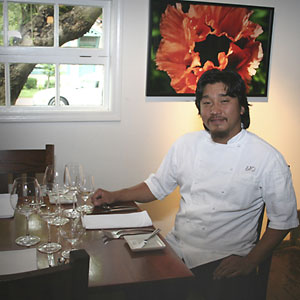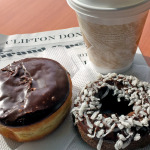 |
| Chef Edward Lee at 610 Magnolia. LEO photo by Nicole Pullen |
LEO’s Eat ‘n’ Blog with Louisville HotBytes
What happens when one becomes so jaded that even the regular dinner at a culinary shrine seems routine? “Ho, hum, dinner at 610 Magnolia again!” Here’s my advice: Kick it up with a special dinner at 610.
Frankly, I don’t think I could ever attain such a level of ennui about the restaurant that’s arguably the region’s best. Chef Edward Lee’s regular menu is a never-ending series of surprises, with exciting new dishes every weekend. But every now and then, Lee pulls off something special. And these events – best tracked by signing up for the e-mail list on the restaurant Web site at www.610magnolia.com – are memorable indeed.
Take last week’s Palindrome dinner.
Say what?
Say “Pal-in-drome.” You know, a word or phrase that reads the same forward or backward. Teddy Roosevelt’s alleged salute to the Panama Canal: “A man, a plan, a canal: Panama.” Or the ancient pick-up line that got left out of Genesis: “Madam, I’m Adam.”
Lee’s culinary invention works something like that, but without the spelling challenges: “The Palindrome is an eight-course dinner where flavors in the savory courses are ‘mirrored’ in the sweet courses. So ingredients in the first course will be repeated in the final course, ingredients in the second course will be repeated in the penultimate course, and so on.”
Made sense to me, sort of. Taste a dish featuring bold flavors in a savory plate, then encounter those flavors again later in the context of dessert. Over a leisurely meal, these tasty reprises would form an edible palindrome.
Things got pleasantly offbeat right at the start, when we came in to 610’s sleek, minimalist venue to find the evening’s menus printed on clear plastic sheets that you had to hold over your white damask napkin to make out.
The first course featured apricots and Riesling wine, which would return in the last dessert. The second dish focused on chili spice and cocoa, which came back in the third dessert. Third dish up featured basil and ginger, flavors repeated in the second dessert. The fourth and final main course presented raisins and sweet potatoes, which turned around and re-introduced themselves in the first dessert.
Eight courses sounds like a lot, but these were small plates. Wine or other adult beverages were served with each course, chosen to match the flavors. Here’s how the Palindrome went down:
1) Two miniature boneless grilled quail breasts the size of quarters were tucked into a vol-a-vent (a tiny cylinder of flaky puff pastry) with a dab of fresh tomato and herbs. It was plated on a bright peach-color apricot vinaigrette. The flavors came together in an amazing buttery effect, eerily reminiscent of movie-theater popcorn. The wine for this and the next course was Smith-Madrone 2005 Riesling from California, floral and stony, a great match with both dishes.
2) Served in a white rectangular dish shaped a bit like a Bose radio, tender lobster meat was rolled into a deep-fried crepe cylinder not unlike a chilaquile, topped with diced mushrooms and plated on paper-thin slices of fennel. The other side of the dish held a square pool of lobster bisque drizzled with chili oil, floating in which was a plump, round ravioli made of chocolate pasta and stuffed with foie gras. Servers offered a tray of crisp flatbreads in 10 rows to choose from. The breads at one end were dusted with cocoa; at the other end, spicy chile powder. In between, a varying mix of both. Just like Baby Bear with his porridge, I found the one in the middle just right.
3) A small block of wild salmon, crispy skin on, was poached in olive oil to just-cooked succulence and plated on a green “pistou,” a French version of pesto floating on green basil oil. Next to it, in a teensy tower the size of a short stack of half-dollars, were alternating rounds of smoked salmon and golden beet, topped with a basil leaf. The combination of flavors was amazing, and it soared with the accompanying wine, a bold pink Boulay 2005 Sancerre Rosé Chavignol from the Loire Valley.
4) Mr. Pork, meet Mr. Pork. On one side of the plate, a small, intense round of falling-apart-tender pork cheek was painted with a sweet golden raisin glaze atop paper-thin scalloped sweet potatoes glued together with mild goat cheese. On the other side, a few small pieces of luscious, fatty pork belly perched on a “risotto” of tiny sweet potato dice and earthy cheese, topped with crisp, needle-thin sweet-potato fries. This came with the only red wine of the night, a pleasantly funky Merio “Néstri” from Italy’s northeastern corner.
Then it was on to the desserts, reversing the key ingredients in palindromic fashion. Madam, I’m Adam. And getting full.
First, raisins and sweet potatoes came back in a Moroccan-style “bisteeya,” normally a savory dish but here rendered as a dessert, a small, moist round of sweet-potato and raisin pie wrapped in crisp phyllo and topped with a mini-scoop of subtle sweet potato ice cream. It was surrounded with crunchy bits of phyllo with a hint of cinnamon flavor. A few drops of saba vinegar, a Italian condiment made from grape juice, a sort of cousin to balsamic, woke up the flavors with a sweet-sour note. This course was paired with Broadbent 10-year-old Madeira Malmsey, a nutty, rich and sweet wine.
The second dessert was a light and cooling treat: A ping-pong ball of dark green basil sorbet was perched on a round of crisp watermelon in an oversized white bowl. Then Chef Lee poured in cold red and yellow watermelon soups from two pitchers, one in each hand, pouring at the same time from opposite sides so they met in the middle. After you ate a little, the bold primary colors all mixed together into a dark olive. It still tasted great. The sorbet was garnished with a tiny julienne stripe of candied ginger and served with a sparkling French pear cider, Poiré Authentique from Eric Bordelet.
Third up was a small round of Mexican-spiced cocoa panna cotta, tasty if a little too dense for pure Italian authenticity – panna cotta should be airy as cream, but this was more like a mousse – with a few decorative hazelnuts on a pool of hot-sweet grapefruit jelly. A chilled mini-martini glass held pink grapefruit juice and soda, a dash of chile flavor and a short shot of tequila.
Fourth and finally, a deconstructed “apricot baklava” featured two apricot slices poached in Riesling wine, sandwiched with a square of flaky phyllo, perched on a schmear of sweet cream cheese and honey. On the other end of the plate was tart-sweet Riesling gelee and a bite of thick, dark-green pistachio paste that tasted remarkably like dark chocolate. It was served with Trimbach 2000 Alsace Cuvee Frederick Emile Riesling, a fine, dry and minerally wine – but it just didn’t play as well as I would have liked with the fruit and sweet cheese.
The dinner was $125 per person plus tip, lofty but not inconsistent with 610’s regular menu at $65 for six courses not including wine. The experience cemented my take on 610 Magnolia as the city’s best restaurant, although the competition remains keen.
610 Magnolia
610 Magnolia Ave.
636-0783
www.610magnolia.com
Rating: 99 points



